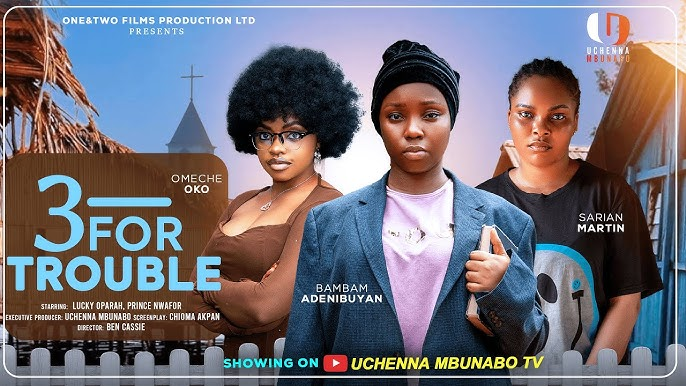The Family Secret That Shattered Three Lives: Is This Nollywood’s Next Essential Watch?
Nollywood is no stranger to family drama, but “THREE FOR TROUBLE,” starring Bambam Adenibuyan, Sarian Martin, and Omeche Oko, doesn’t just deliver drama—it detonates it. Clocking in at almost two and a half hours, this Nigerian feature is less a gentle narrative and more a harrowing psychological indictment of societal rot, particularly surrounding trauma, religion, and the deadly silence within families. The film throws the viewer into the chaotic, poverty-stricken home of three vastly different sisters—Naomi, Deborah, and Kaziah—whose perpetual conflict seems utterly unmotivated until a final, gut-wrenching reveal connects their adult pathologies back to a single, shared monster from their past: Chief Romanos.
This is a film that demands your attention, not for its polish, but for its searing, uncomfortable themes. It’s a messy, ambitious work that attempts to juggle three heavy subplots—religious zealotry, sexual identity, and survival sex work—all while building towards a moment of shared, traumatic recognition. The result is a sprawling, often melodramatic, but ultimately essential piece of social commentary that cuts deep into the Nigerian psyche. If you can handle the emotional marathon and the occasional uneven pacing, Three for Trouble is a powerful, if flawed, narrative that sticks to your ribs.
The Burden of Identity: Analyzing Naomi, Deborah, and Kaziah
The film’s entire scaffolding rests on the performances and characterizations of the three leads, and it is here that the complexity—and the occasional challenge—lies. The film treats the adult personalities of the three sisters not as standalone quirks, but as protective shells built desperately over a shared, hidden wound.
Naomi: The Zealous Tailor and the Cracks in the Faith
Naomi (Sarian Martin) is the most visibly “pious” of the trio, a sharp-tongued tailor who preaches scripture while running a business. Her character is a thinly veiled critique of the hyper-religious facade often seen in African society. Her zealotry is not born of peace, but of repression; she weaponizes Christianity to judge her sisters and maintain an impossible standard of righteousness. Martin’s performance captures the frantic energy of a woman trying to outrun her past by performing sanctity. We see the cracks when she begrudgingly accepts a tailoring job to sew indecent apparel for Chief Romanos’s mistress—a moment of moral compromise driven by poverty, which subtly foreshadows the larger moral compromises of her youth. Sarian Martin leans into the melodrama, particularly in the long, drawn-out church scenes, but she successfully establishes Naomi’s self-righteousness as a fundamental defense mechanism.
Deborah: Aggression, Atypical Gender Expression, and Rage
Deborah (Omeche Oko) is arguably the film’s most nuanced character. Presented as highly aggressive and masculine-presenting, she is the sister who is constantly spoiling for a fight, acting as the family’s volatile enforcer. Her rage is palpable, manifesting in physical confrontations and an unwillingness to conform to gender norms. The film does a solid job of using her atypical presentation and unbridled anger as a continuous, unexplained consequence of underlying psychological damage. Oko’s performance, while intense, manages to keep Deborah grounded as a person perpetually on edge, reacting to the world as if it is a constant threat. Her identity choices, which lead to conflict with the conservative Naomi, are beautifully revealed late in the film to be another protective identity, a way to build a wall of hardness against vulnerability.
Kaziah: The Hustler and the Cost of Survival
Kaziah (Bambam Adenibuyan) is the pragmatic sister who turns to sex work to survive, making her the most vilified by Naomi. Her character embodies the intersection of poverty and morality, forcing the audience to confront the economic realities that drive moral choices. Adenibuyan provides a compelling portrayal of someone who has chosen a path of lesser shame to simply live, but whose cynicism is a thick coat of self-loathing. Her choice of profession is the physical manifestation of the vulnerability they all experienced in their childhood; she is, in a way, reclaiming control over her body by selling its labor, a tragic irony the film effectively conveys.
The strength of the film lies in the final act when the sisters, pushed to their breaking point, finally discover that their wildly divergent adult lives are all symptoms of the same disease: the molestation they suffered at the hands of Chief Romanos. This shared revelation is the emotional payoff that justifies every exaggerated argument and personality clash preceding it.
When the Pastor Sews: The Pacing and Narrative Juggling Act
At a hefty 145 minutes, Three for Trouble feels every bit its runtime. The prompt correctly asks if the length is justified, and the answer is complicated.
Fragmentation vs. Depth
The film attempts to run three distinct character studies simultaneously, and this ambition leads to periods of narrative fragmentation. We spend extensive time on Naomi’s church activities and tailoring dilemmas, Deborah’s street fights, and Kaziah’s encounters with clients. While these scenes meticulously build up their individual walls, the sheer weight of these subplots often stalls the central conflict.
The pacing suffers most in the first two acts. The prolonged church scenes, necessary to establish Naomi’s hypocrisy, feel excessively long and repetitive. Similarly, the frequent domestic arguments between the sisters, while important for showing their broken dynamic, become visually and emotionally exhausting.
However, the director deserves credit for the slow-burn approach to the central mystery. The deliberate, meandering pace means that when the revelation of the shared trauma finally lands, the emotional impact is amplified tenfold. The film forces the audience to live with the sisters’ misery, which makes the source of that misery feel exponentially heavier when it surfaces. The long runtime is justified not by efficient storytelling, but by necessary immersion in the characters’ damaged lives.
The Rot Within: Trauma, Silence, and the Nigerian Church
The thematic core of Three for Trouble is devastatingly potent. This is where the film transcends simple melodrama and enters the realm of essential social commentary.
The Long-Term Psychological Damage
The film offers a brutal, clinical look at trauma and silence. By making the sisters’ adult identities—the zealot, the aggressor, and the sex worker—direct, understandable consequences of childhood abuse, the film achieves a rare depth. Naomi’s judgmental rigidity is her effort to control a world she felt powerless in; Deborah’s aggression is a pre-emptive defense against further violation; and Kaziah’s emotional detachment is a survival mechanism. The film makes a crucial statement: the silence surrounding abuse doesn’t just damage children; it destroys the adults they become, dictating their entire life choices and identities.
The Problem of Religious Hypocrisy
The critique of religious institutions is sharp and relentless. Naomi’s character, combined with the presence of Pastor Akachi, drives home the theme of religious hypocrisy. We see Christian figures more concerned with outward appearance, church funding, and maintaining their own moral authority than with justice or truth. The plot point where Pastor Akachi is implicated in another shady deal subtly widens the scope of the critique: the rot is systemic, not isolated to one family. The film asks: how can institutions that preach salvation fail so miserably in protecting the most vulnerable? This commentary resonates deeply with the socio-political reality of contemporary Nigeria.
Poverty and Compromise
Finally, the film powerfully links poverty with moral compromise. The sisters’ desperation is not a backdrop; it is a driver of the plot. Their reliance on Romanos’s “benevolence” in the past made them vulnerable, and their current financial struggles ensure they remain morally compromised (Naomi sewing the ‘indecent’ clothes). Kaziah’s chosen profession is the starkest expression of this—a choice necessitated by economic survival, not moral depravity, a fact the film treats with an empathetic, non-judgmental eye.
The Executioner: Chief Romanos and the Problem of Evil
Chief Romanos is the film’s crucial, yet slightly under-developed, antagonist.
Nuance vs. Necessity
The prompt asked if Romanos is a purely one-dimensional villain. Initially, he is presented as a community benefactor, a man of power and wealth, which makes the later revelation of his predatory nature more sickening. However, once his true identity is revealed, the film does not spend much time exploring his manipulation or psychology; he quickly becomes the target of the sisters’ revenge.
While a more nuanced villain might have added psychological complexity, the film’s focus is rightly on the survivors, not the perpetrator. Romanos serves as the necessary, external catalyst for the sisters’ eventual unity. His lack of nuance simplifies the moral landscape, allowing the audience to focus solely on the cost of his actions rather than his motivation. His character is thus effective in his function, if not in his depth.
Technical Notes: Dialogue and the ₦100 Million Ending
The technical execution of Three for Trouble is generally solid by contemporary Nollywood standards, though it has some notable stylistic choices.
Language and Authenticity
The dialogue is a strong point. The seamless and authentic integration of English, Nigerian Pidgin, and native language grounds the film in its cultural context. The arguments between the sisters feel raw, real, and frequently utilize the pointed vernacular of Pidgin, lending an authenticity that pure English dialogue often lacks. However, some of the more emotional confrontations lean heavily into dramatic, expository speeches, sometimes pulling the viewer out of the moment.
The Resolution: A Sudden Shift
The film’s climax is perhaps its most debatable element. After nearly two hours of intense, psychological drama, the resolution shifts into a more action-oriented, transactional territory. The sisters unite to blackmail Romanos for a staggering ₦100 million.
While the unity of the sisters is emotionally satisfying—they finally put aside their differences to face their shared monster—the specific choice of blackmail for a huge sum feels like a sudden departure. It’s an ending that is dramatically decisive but somewhat undercuts the emotional and moral weight built up by the trauma storyline. It trades a messy, complicated path to justice (e.g., reporting the crime, facing the societal backlash) for a clean, financially punitive revenge. It’s a compelling, if slightly convenient, closure that ensures the sisters achieve both emotional victory and financial freedom, sidestepping the difficult legal and social hurdles.
Verdict and Call-to-Watch
“THREE FOR TROUBLE” is a film that successfully lands its emotional haymaker despite its structural flaws. It is too long, occasionally too loud, and its resolution is arguably too neat, but its thematic ambition and the raw intensity of its performances cannot be ignored. The film’s greatest success is its bold articulation of how sexual trauma, when suppressed, metastasizes into destructive, divergent adult identities, forcing the audience to look past the surface-level vices of the sisters (zealotry, aggression, sex work) and see the shared, vulnerable humanity beneath.
It is a powerful piece of filmmaking that serves as a vital conversation starter about silence, institutional failure, and the long road to healing. It’s not an easy watch, but it is an important one.
Rating: ………………… 4/5 Stars
CALL TO WATCH: If you’re tired of Nollywood films that shy away from genuine social commentary, find Three for Trouble. Grab a friend, settle in for the long haul, and be prepared for a difficult but necessary conversation afterward. This film is a cultural thermometer—and the reading is high.
#NollywoodTimes
#ThreeForTrouble2025
#NollywoodComedy
#BambamAdenibuyan














Leave a Reply